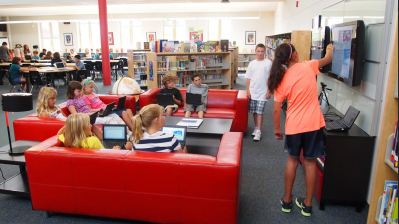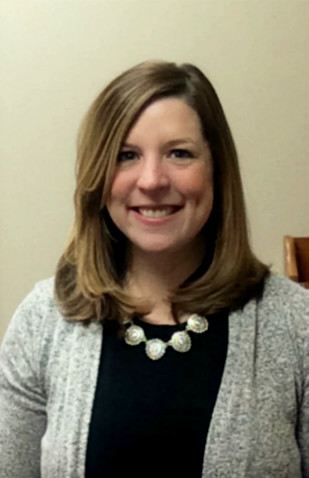Teaching for Learning: Social Learning
Update December 2020:
This web page is a companion to the 2016 version of the School Library Program Rubric. NYSED released an updated School Library Program Rubric in December 2020.
Student Snapshot: Students develop skill in sharing knowledge and learning with others both in face-to-face situations and through technology.
Rosenfield and Loertscher (2007) state, “social learning is a pedagogical style inherent in problem-based, inquiry-based, and project-based learning. In social learning, students learn both content and process from each other. Today’s technology supports social learning through asynchronous communication. Students not only learn content, but they also see how other students work together to share and build knowledge”.
Source: Rosenfeld, Esther, and David V. Loertscher. Toward a 21st-century School Library Media Program. Scarecrow, 2007.
Citation for Photo: Flickinger, Brad. 2012. Flickr.
This web page features a photo by Brad Flickinger, available under Creative Commons Attribution 2.0 Generic license.
In Practice
Creative spaces: flexible environments for the 21st-century learner
Description: One Georgia school district has transitioned to a learning commons model which their librarians describe. They address how it was developed, essential components, and how it is impacting their students.
Resource/Citation: Helfrich, Jennifer. "Creative spaces: flexible environments for the 21st-century learner." Knowledge Quest, vol. 42, no. 5, 2014, p. 76.
From Library to Learning Commons: Our Crescent Heights High School Experience
Description: A school librarian relates her experience transitioning the space in her library to a responsive, flexible, innovative and collaborative student-centered hub in her school.
*Resource/Citation: Mueller, Lisa. "From library to learning commons: our Crescent Heights High School Experience." Teacher Librarian, vol. 43, no. 1, 2015, p. 12.
Beyond Walls: Hosting a Virtual Picture Book Smackdown
Description: The article offers tips for grade school librarians on how to host a virtual picture book challenge. Topics discussed include the details of a shelf challenge wherein students have to set a goal for themselves to read a certain number of books, the use of social networking sites like Twitter to inform the students about the challenge and the activities involved in preparation for and during the live hangout including the distribution of invitations to schools and authors.
Resource/Citation: Plemmons, Andy. "Beyond Walls: Hosting A Virtual Picture Book Smackdown." Library Sparks, vol.12, no. 5, 2015, pp. 19-21.
iStaff: a judgement-free community
Description: This article is about how students, in grades 6-8, at Pine Grove Middle School work in roles of leadership with the school library in a program that honors and optimizes their interests, their talents, and their diversity.
*Resource/Citation: Kowalski, Sue. "iStaff: a judgement-free community." Teacher Librarian, vol. 42, no.1, 2014, p. 23.
Earth Pals
Description: This article is about a sixteen-week student-driven inquiry collaboration. “Earth Pals is a multifaceted technology integration project collaboration between two schools, encompassing two libraries and two classrooms.” “The project ...goal [was] a presentation created by the students and delivered to peers, staff members, and the online community in which the project and research were explained and the audience was challenged to think differently about the world around us.”
Resource/Citation: Winner, Matthew, and Sherry Gick. "Earth pals". Teacher Librarian, vol. 41, no. 2, 2013, p. 38.
Library to Learning Commons-Saanich School District (No. 63)
Description: The Saanich School District (No. 63) is transitioning their library spaces to a Learning Commons model. These innovative changes to the physical and digital space, resources, and staffing are transforming learning, teaching, collaboration and professional-development for students and staff in our schools.
Resource/Citation: Saanich School District. :”Library to Learning Commons - Saanich School District (No. 63)”. YouTube, uploaded by Saanich School District, 29 Apr. 2014.
Connected learning: linking academies, popular culture, and digital literacy in a Young Urban Scholars book club
Description: “A connected learning approach draws on the three major spheres of influence in a teens' life: academics, interests, and peer culture. [We] can use those areas as a foundation for guided inquiry and engagement with teens.” A school librarian uses the framework to connect youth of color in her book club and with books that mirror more than their cultural experiences.
Resource/Citation: Kumasi, Kafi. "Connected learning: linking academies, popular culture, and digital literacy in a Young Urban Scholars book club”. Teacher Librarian, vol. 41, no. 3, 2014, p. 8.
In Theory
Guided Inquiry: Learning in the 21st Century: Self and Peer Assessment
Description: “Based on Kuhlthau’s 6 stage “Information Search Process,” the authors present [the compelling case for] recasting Guided Inquiry as a dynamic, innovative way of developing information literacy.“ The rationale and theory for adopting a guided inquiry approach to education is presented as well as an exploration of the expertise, roles, and responsibilities of each member of an instructional team.
*Resource/Citation: Kuhlthau, Carol C., Leslie K. Maniotes, and Ann K. Caspari. Guided Inquiry: Learning in the 21st Century. Libraries Unlimited, 2015.
Skype and the Embedded Librarian
Description: “Retired school librarian Diane Cordell is cultivating a network of learning partnerships around the globe to teach students of all ages the art of photography and digital storytelling. Diane shares how she established these collaborative relationships with teachers and librarians and how her role as an embedded librarian has supported passion-based learning and created virtually connected communities of learners.”
Resource/Citation: Cordell, Diane. "Skype And The Embedded Librarian." Library Technology Reports, vol. 48, no. 2, 2012, pp. 8-11, https://journals.ala.org/ltr/article/view/4363.
Building Healthy and Sustainable Communities for Youth: Life Skills, School Libraries, and Social Involvement
Description: Healthy communities are based on social justice and mutual respect. Healthy communities for youth promote values such as fairness, equal treatment, accountability, opportunity, participation, and opportunities to make choices. School librarians serve communities when they develop venues ensuring the development of social values and personal life skills for youth. Workable suggestions, including reading programs, for a variety of school situations are provided.
Citation: Immroth, Barbara, and Bernard W. Lukenbill. "Building Healthy And Sustainable Communities For Youth: Life Skills, School Libraries, And Social Involvement." IASL Conference Reports, 2013, pp. 60-73.
Confronting the Challenge of Participatory Culture: Media Education for the 21st Century
Description: “Many teens today who use the Internet are actively involved in participatory cultures—joining online communities ..., working in teams to complete tasks and develop new knowledge..., and shaping the flow of media .... A growing body of scholarship suggests potential benefits of these activities, including opportunities for peer-to-peer learning, development of skills useful in the modern workplace, and a more empowered conception of citizenship.” A central goal of this report is to shift the focus of the conversation about the “digital divide from questions of technological access to those of opportunities” to participate and to develop the cultural competencies and social skills needed for full involvement.
Citation: Jenkins, Henry. “Confronting the Challenges of Participatory Culture: Media Education for the 21st Century”. MacArthur Foundation, 2009.
Consultant
Name: Nicole Waskie-Laura
Email: nwaskiel@btboces.org
Bio: Nicole Waskie-Laura is the School Library System Coordinator at Broome-Tioga BOCES in Binghamton, NY. Prior to her current position, Nicole was an elementary school librarian for 6 years. Nicole holds a B.A. in Literature from SUNY Geneseo, a M.L.S in Information/ Library Science from the University of Buffalo, and a M.Ed. in Educational Administration from the University of Scranton.
*To access restricted database articles speak with your school librarian or public librarian.







